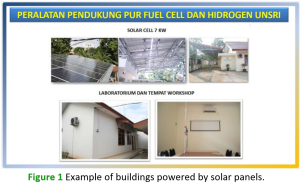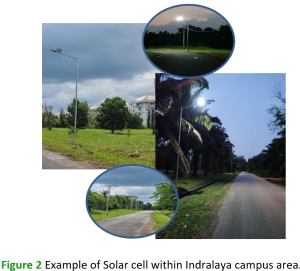
SDG 13 – Indicator 13.2.1 Low-carbon energy tracking
Sriwijaya University utilizes energy from both the Indonesia State Electricity Company (PLN) and its own solar panels. While initially only one building and some outdoor lighting were powered by renewable energy, the university has been progressively incorporating solar power into more buildings. Notably, solar panels have been strategically placed to cater to the energy needs of the Fuel Cell and Hydrogen Research Center of Excellence, which primarily relies on this renewable source for electricity. If the center’s power demand surpasses the solar panels’ capacity, the deficit is supplemented by the PLN grid. Conversely, any surplus energy generated by the solar panels, when the laboratory’s power requirements are low, can be fed back into the PLN network.In addition, solar cell lamps of 600 watts have been installed both in Palembang and in Indralaya campuses:
- Faculty of Economics = 27 units,
- Faculty of Engineering = 27 units,
- Along the access roads at Palembang campus = 27 units, and
- Along the roads within Inderalaya Campus = 47 units
The total energy generated by the solar cell is 85.8 KW (or 4 GJ, assuming 12 hours operation time).

Sriwijaya University actively monitors its energy consumption to identify areas for improvement and promote sustainability. This monitoring process adheres to the Indonesian National Standard SNI:6196-2011, which provides guidelines for conducting energy audits, specifically focusing on building envelopes (https://www.iea.org/policies/7870-sni-61962011-on-energy-audit-procedure-for-building). This standard helps ensure a systematic and comprehensive approach to evaluating energy performance. The collected energy usage data is then processed and analyzed using the EDGE (Excellence in Design for Greater Efficiencies) certification system ( https://edge.gbci.org/). EDGE is a green building certification system developed by the International Finance Corporation (IFC) that helps assess and improve the resource efficiency of buildings. To illustrate the practical application of this approach, the Faculty of Law Tower on the Palembang Campus served as a case study. The energy performance of this building was thoroughly analyzed using the SNI:6196-2011 guidelines and the EDGE software. This analysis was part of a research project conducted by a team of academics from the Faculty of Engineering at Sriwijaya University, demonstrating the university’s commitment to energy efficiency and sustainable practices.
(https://drive.google.com/file/d/10OtF59NWazUtIzgfUVWxe2e75HAgSRHh/view?usp=drive_link)
Students at Sriwijaya University are actively involved in promoting renewable energy by participating in the Society of Renewable Energy (SRE). SRE is a non-profit organization established in 2019 with the mission of accelerating Indonesia’s transition towards renewable energy sources. They achieve this goal by focusing on capacity building initiatives, such as workshops, training programs, and educational outreach, which empower individuals and communities to adopt and implement renewable energy technologies. SRE’s efforts contribute to a sustainable energy future for Indonesia by fostering knowledge, skills, and awareness regarding renewable energy solutions. (https://www.instagram.com/sre.unsri/p/Cyiu78bPjIX/?img_index=1)

SDG 13 – Indicator 13.2.2 Low-carbon energy tracking
Total energy used: 11171 GJ
Total energy used from low-carbon sources: 4 GJ
In 2023, Universitas Sriwijaya formed a research and development partnership with CIFOR and ICRAF, two organizations focused on forestry and agroforestry. This collaboration aims to improve Indonesia’s environmental sustainability. CIFOR is a global non-profit promoting human well-being, environmental conservation, and equity. ICRAF is a research institution dedicated to science-based solutions in the same areas.
Link:
